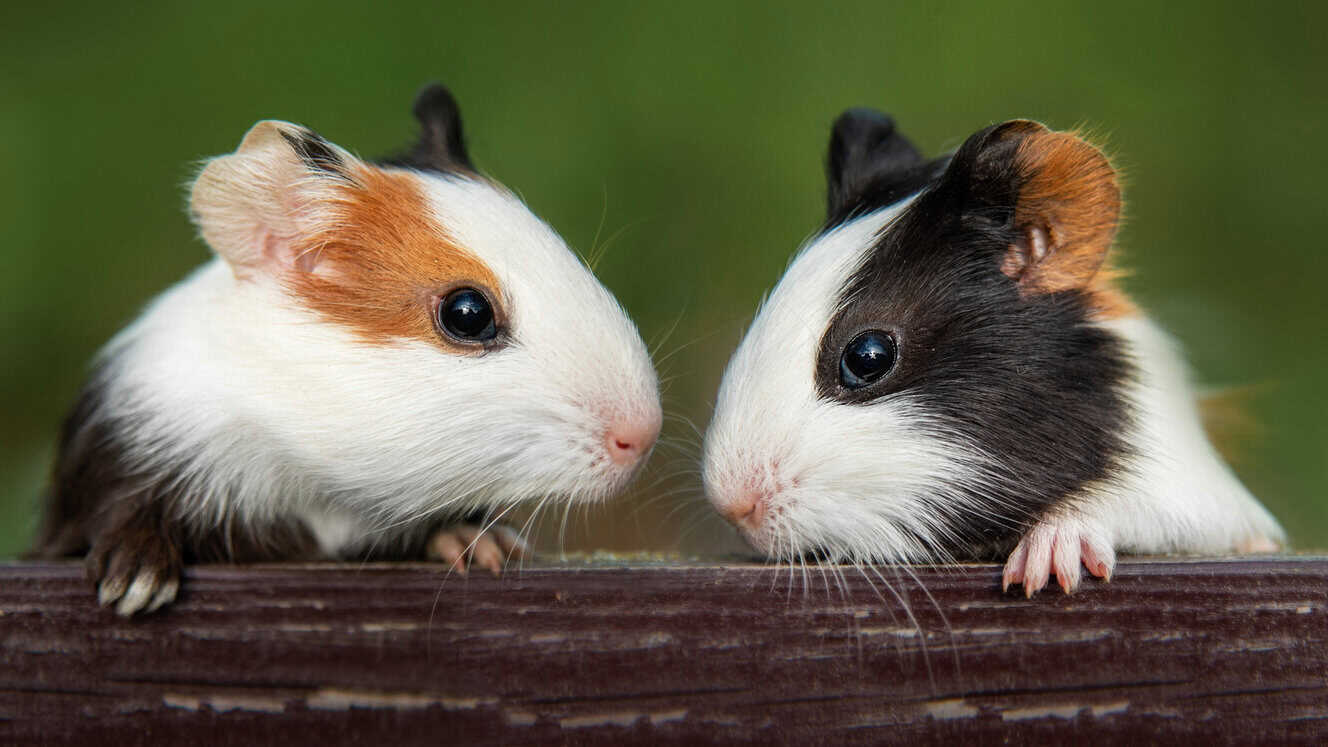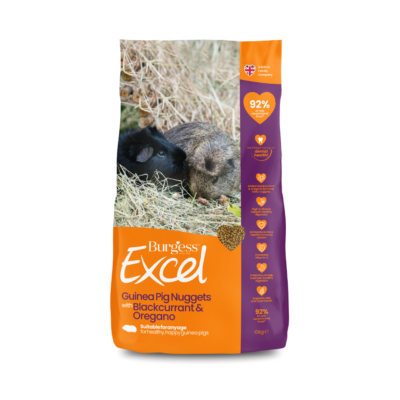
Guinea pigs are small, social rodents who make marvellous companions – which is something that humans first discovered many millennia ago. Today, thanks to their gentle ways and charming personalities, guinea pigs now enjoy their status as one of the most popular pets of all time– an accolade they totally deserve!
So where did it all begin? It’s believed that the budding relationship between people and piggies began as early as 5000 BC. Centuries later, Spanish, Dutch and English traders brought domesticated guinea pigs from South America to Europe in the 1500s, where they quickly became fashionable as exotic pets among the well-to-do.
In 1888, the National Cavy Club (NCC) was established to promote and support the breeding, showing, and welfare of purebred guinea pigs. By the middle of the 20th century, guinea pigs had become familiar pets in many households. Today, these chatty little animals continue to go from strength to strength in the pet popularity stakes.
Early ancestors
Before they were domesticated and eventually become the pampered pets we know and love today, Cavia porcellus, to give them their Latin name – porcellus translates as ‘little pig’ – wild guinea pigs (the Andean Cavia tschudii) roamed the grassy plains, rocky outcrops, and forest edges of the Andes region in Peru, highland Bolivia, northwestern Argentina, and northeastern Chile.
It's been quite a journey from a life on the South American plains to becoming much-loved pets – and it hasn’t always been an easy ride for these perky, plump, affectionate rodents, as our guinea pig timeline reveals.
A BRIEF HISTORY OF GUINEA PIGS
- 5000 BCE The original human inhabitants of the Andean region – present day Ecuador, Peru and Bolivia – began to domesticate wild guinea pigs as a source of food as people began to transition from a nomadic to an agricultural lifestyle. In fact, they’re still a culinary staple in the Andes Mountains, where their meat is known as cuy.
- 100-800 CE The Moche people of ancient Peru worshipped guinea pigs and incorporated them into their folk art, sculpture and handicrafts. The Incas, meanwhile, sacrificed them to their gods!
- 1200-1500 The ancient Peruvians bred increasingly exotic varieties of guinea pigs as companion animals. Many of these had fur and colouring very similar to the varieties we know today.
- 1500s As trade from South America to North America and Europe took off in the 16th century, guinea pigs became popular imports. They were highly prized as exotic pets, especially among members of the royal courts. Queen Elizabeth I was one of the first European fans of guinea pigs. And, with such esteemed royal patronage, it’s no surprise that fashionable and wealthy Elizabethans jumped on the trend of having guinea pigs as pets.
- 1554 The first written description of guinea pigs in the West was in 1554 by the Swiss naturalist Conrad Gessner, regarded as the father of modern scientific bibliography, zoology and botany.
- 1575 The oldest recorded guinea pig remains in England were found at Hill Hall, an Elizabethan manor house in Essex, during excavations in the 1980s, and were dated to around 1575.
- 1580 The earliest-known European illustration of a domestic guinea pig is a painting at the National Portrait Gallery in London, dated to 1580, which shows an Elizabethan girl holding a tortoise-shell guinea pig in her hands.
- 1800s Science came on in leaps and bounds during the 19th century and, due to their small size and docile natures, and some biological similarities to humans, guinea pigs were often used in laboratory tests. While scientific breakthroughs may have been made through these early experiments, life was sad for many guinea pigs at this time. Today, the UK government aims to phase out all animal testing and is working to develop non-animal methods (NAMs) of research.
- 1900s Due to a combination of factors including economic prosperity and the rise of the pet industry, pet ownership really started to take off in the 1900s. The 20th century also saw a shift in cultural attitudes, with pet animals becoming a valued part of family life, providing companionship and emotional support. Along with dogs, cats, rabbits and hamsters, guinea pigs became increasingly popular pets.
- 2025 Today in the UK alone, there are an estimated 700,000 pet guinea pigs and they are the nation’s eighth most popular pet! The British Cavy Council currently recognises 15 Specialist Breed Clubs and more than 50 guinea pig breeds including Abyssinian, Peruvian, Sheltie and English Crested.
Help guinea pigs to live their best lives by seeing things from a piggy perspective >>
WHY ARE GUINEA PIGS CALLED GUINEA PIGS?
Guinea pigs don’t come from Guinea so the ‘guinea’ in their name is a bit of a mystery. One theory is that they were first brought to Europe by Spanish explorers in the 1500s via Guinea in Africa, so people thought they came from there, or it could be a corruption of ‘Guiana’, an area in South America. Another possible source of their name is from of the class of ships—the Guineamen – that transported them from South America to Europe.
Also, as they’re rodents and not related to pigs at all (even though male guinea pigs are called boars and females are called sows) the ‘pig’ part of their name is rather puzzling too. This name may have come about because of the pig-like squeaking noises they make – but no one really knows!
SOME ASTONISHING FACTS ABOUT GUINEA PIGS
If you’re obsessed with all things guinea pig, you’ll love finding out more about them with these captivating cavy facts...
- BORN THIS WAY Young guinea pigs are born fully formed and can scamper about and eat solid food the day they are born, although they are not fully weaned for about three weeks. Females mature in two months, males in three, and pet guinea pigs live up to eight years – sometimes even longer!
- SOCIAL ANIMALS Guinea pigs often huddle up together for warmth and protection and prefer to be in close contact with other guinea pigs. Male guinea pigs form social hierarchies over food and mates, typically resulting in an alpha male within the group. For this reason, females are not typically housed with more than one male.
- CHATTY CHUMS Guinea pigs produce six main vocalisations: chutts, squeaks, whines, whistles, purrs and chirps. Each conveys a different meaning. For example, squeals, squeaks and tweets indicate the presence of danger, and whistles and chirps convey the presence of food and are used for long-distance communication.
- WHISTLE BLOWERS Guinea pigs that bond with their owner will whistle on their approach – they will also learn to whistle in response to the rustling of bags or the opening of refrigerator doors, where their fresh food is most commonly stored!
- FIELD OF VISION Guinea pig eyesight is not as good as that of a human in terms of distance and colour, but they have a wider angle of vision than us (about 340°) – useful for spotting potential predators. They do, however, have well-developed senses of hearing, smell, and touch.
- ROUTE MASTERS Guinea pigs can learn complex paths to food and can accurately remember a learned path for months.
- PROTECTION ORDERS As prey animals, guinea pigs have developed two defensive responses: the immobility response and the scatter response. The immobility response occurs when a single guinea pig perceives danger. During this response, the guinea pig becomes completely immobile until the threat has passed. The scatter response involves a group of guinea pigs. When the group perceives a threat, they scatter and split up to confuse a predator.
- NAP KNOW-HOW Pet guinea pigs have developed a different biological rhythm from their wild counterparts and have longer periods of activity followed by a short sleep in between. This is why pet guinea pigs need access to all their resources at all times.
- VITAMINS ARE VITAL Like humans, but unlike most other mammals, guinea pigs cannot synthesize vitamin C and must obtain this vital nutrient from food. If guinea pigs do not ingest enough vitamin C, they can suffer from potentially fatal scurvy – the sailor’s disease of old. Guinea pigs can get their daily vitamin C by eating guinea-pig safe fresh fruits and vegetables such as broccoli, apple, cabbage, carrot, celery, and spinach and from pellets specially designed for guinea pigs.
Sources: Four Paws, Smithsonian’s National Zoo & Conservation Biology Institute, Britannica, Wikipedia
12 fun facts about gorgeous guinea pigs >>
CARE MORE Discover more about meeting the needs of your guinea pigs with our Guinea Pig Care Guide >>
* While it’s lovely for children to enjoy the company of guinea pigs, the responsibility for any animal’s wellbeing lies with adults. Small animals are often more complex to feed and care for than a cat or dog and require more looking after than a child can offer. *
92% of UK vets recommend the Burgess Excel small pets range
Guinea pig nuggets should be high in beneficial fibre to support your guinea pigs’ digestive health, contain vitamin C and antioxidants to support their immune system, and be fortified with vitamins and minerals to support healthy eyes, skin and coat.
All Burgess Excel small pets nuggets, feeding hay and healthy treats for guinea pigs are made using only the finest quality ingredients. And, as well as a choice of yummy Nuggets with Mint or Blackcurrant & Oregano there’s also a variety featuring Calm formula with added L-tryptophan specially for indoor guinea pigs and our brand new recipe created especially for senior guinea pigs. And don’t forget some nutritious guinea pig treats to help keep boredom at bay!
Are your guinea pigs Burgess guinea pigs? Join the Burgess Pet Club for exclusive offers and rewards.
If you found this interesting, you may also like:
SPRING CLEANING? WHY GOOD HOUSEKEEPING IS A SMALL PET ESSENTIAL Keeping your small pets’ home clean, tidy and hygienic will discourage pests from making an unwanted appearance and keep your small furry friends healthy and happy.
WHAT’S IN SEASON? HOW TO CHOOSE SAFE, FRESH FOOD FOR YOUR SMALL PETS What better way to add variety to your small pets’ daily dinners than by selecting safe fruits, vegetables and leafy greens to nibble on? You could also forage for some tasty titbits yourself or even grow your own!
WHAT’S ON THE MENU FOR THE MORE MATURE GUINEA PIG? Guinea pigs are living longer – yay! And, if you have an older guinea pig, you’ll be delighted to hear that the experts at Burgess Excel have developed a brand-new variety of food just for them!
BIG UP THE HAY! Did you know that for small furries such as rabbits, guinea pigs, chinchillas and degus, hay should be the BIGGEST part of their daily diet?
WHY YOUNG GUINEA PIGS DON’T NEED LIFESTAGE FOOD Unlike puppies, kittens and baby rabbits, baby guinea pigs are born fully formed and eat solid food almost straight away. So, what do they need from their diet?
SMALL PET MUMS ARE BIG ON LOVE Let’s celebrate small pet mums for the amazing job they do bringing up their tiny babies!
GUINEA PIG Q&A Are guinea pigs good pets for children? How long do guinea pigs live? What do guinea pigs like to do? What should you feed guinea pigs? How can you tell if your guinea pigs are happy? We’ve all the answers to these questions and more.
HOW TO GROOM YOUR GUINEA PIGS From the brush and browse, ear clean, dental check and nail trim to the grease gland wipe, discover more about the essentials of guinea pig grooming with our 5-step guide.
HOW TO HANDLE SMALL PETS Small pets need very careful handling. What’s more, gentle handling helps to build trust between you and your small pet chums, enabling them to thrive and enjoy their interactions with you.
WHAT’S THE BEST BEDDING FOR SMALL PETS? Whichever small pets you have, each has different requirements when it comes to creating a cosy, safe snoozing space. Discover how to make the best bedding choices for your small furry friends – which is extra important during the colder months of the year.
WHAT PUTS YOUR SMALL PETS IN A GOOD MOOD? Along with socialising with their same species companion and interacting with their favourite human, our survey reveals the best thing you can to do to give your small furries a happiness boost…
CAN GUINEA PIGS EAT BANANAS? Can guinea pigs eat apples? Can guinea pigs eat grapes? Can guinea pigs eat celery? What about strawberries, tomatoes, courgettes and cucumbers? What fresh foods should you never give to your guinea pigs?
INTRODUCING A NEW GUINEA PIG FRIEND A solo guinea pig is not likely to be a very happy guinea pig. These chatty cavies need at least one other piggy for company. However, introducing one guinea pig to another has to be done very carefully.
HOW DO YOU CREATE AN IDEAL HOME FOR YOUR INDOOR GUINEA PIGS? Traditionally thought of as outdoor pets, more and more people prefer to keep their guinea pig friends indoors – and there are lots of good reasons why. Yet however cosy and stylish your indoor piggies’ home is, it also needs to meet all their health and wellbeing requirements.
LOST IN TRANSLATION? GUINEA PIG SPEAK EXPLAINED Guinea pigs generally have plenty to say, using around 11 different noises to communicate how they’re feeling. Getting to know what the various piggy sounds means will help you understand your pets better – and can also help you identify when they’re happy and excited or fearful and unwell.
RABBITS AND GUINEA PIGS – IS INDOORS OR OUTDOORS BEST? Is the outdoor life better for bunnies and guinea pigs, or will these small pets have a more enriching time if they’re kept indoors?
COST EFFECTIVE WAYS TO LOOK AFTER YOUR SMALL PETS From creating DIY boredom breakers to upcycling old furniture and unwanted items from around the house into interesting features for your pets’ environment, here are 8 great ideas for you to try out.
WILD AT HEART Inside every pampered small pet is the desire to exhibit their innate, hardwired, natural behaviours which reveal their wild origins. It’s the reason why bunnies want to burrow, guinea pigs like to keep a watchful eye on from a safe hiding place, hamsters stuff food in their cheek pouches and chinchillas prefer to sleep hunched up. Find out more about the natural and fascinating behaviours of some of our favourite small furries.

















